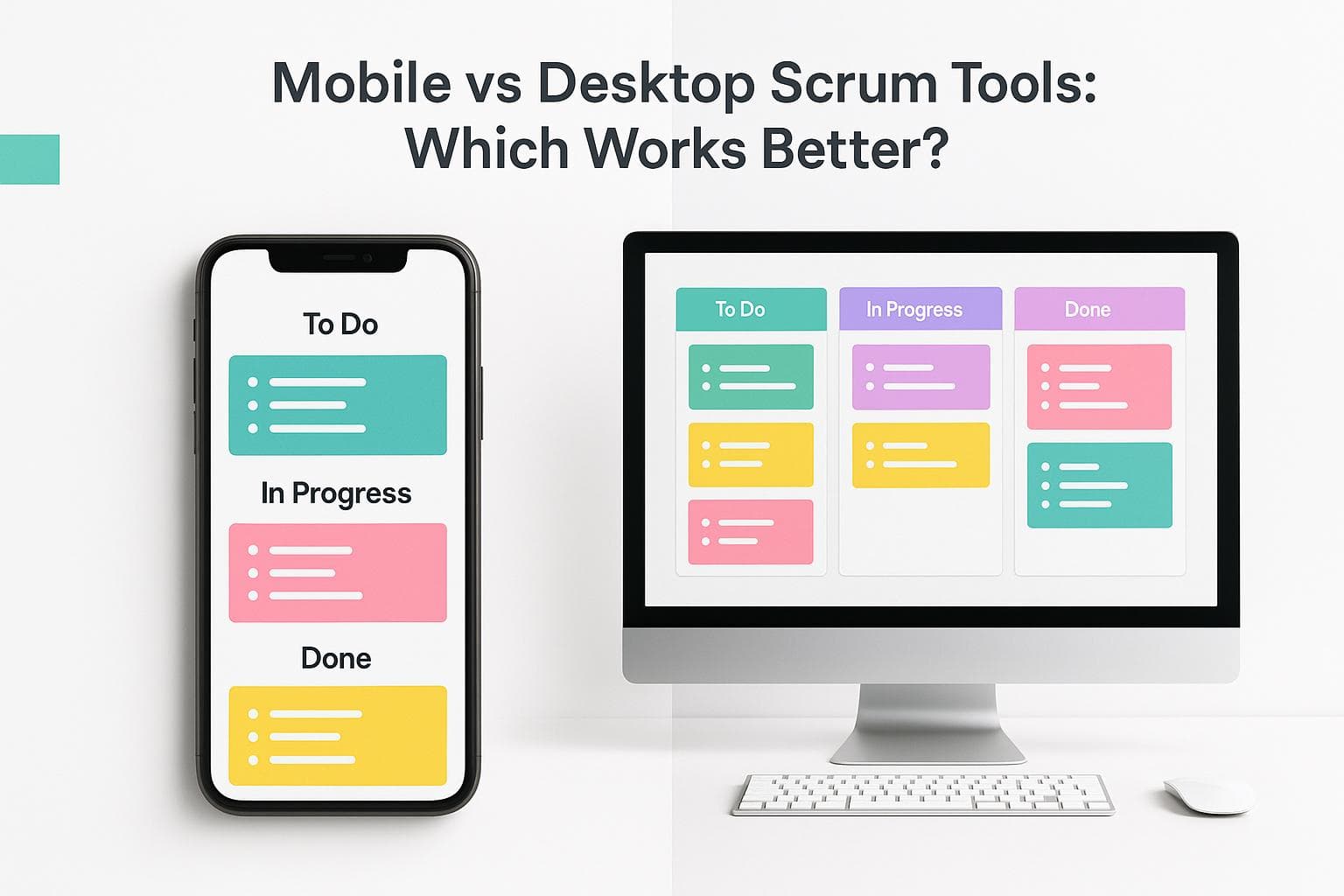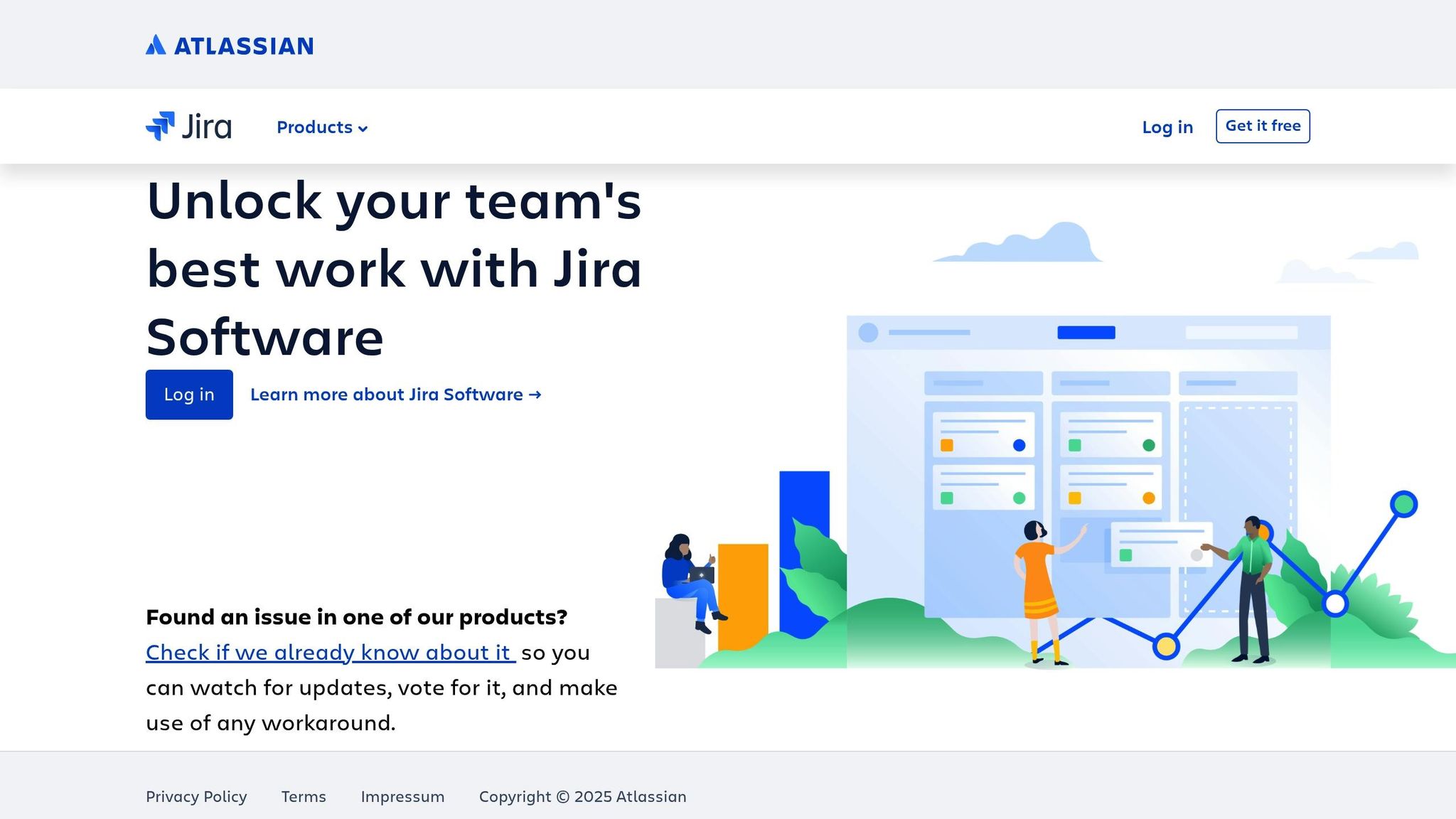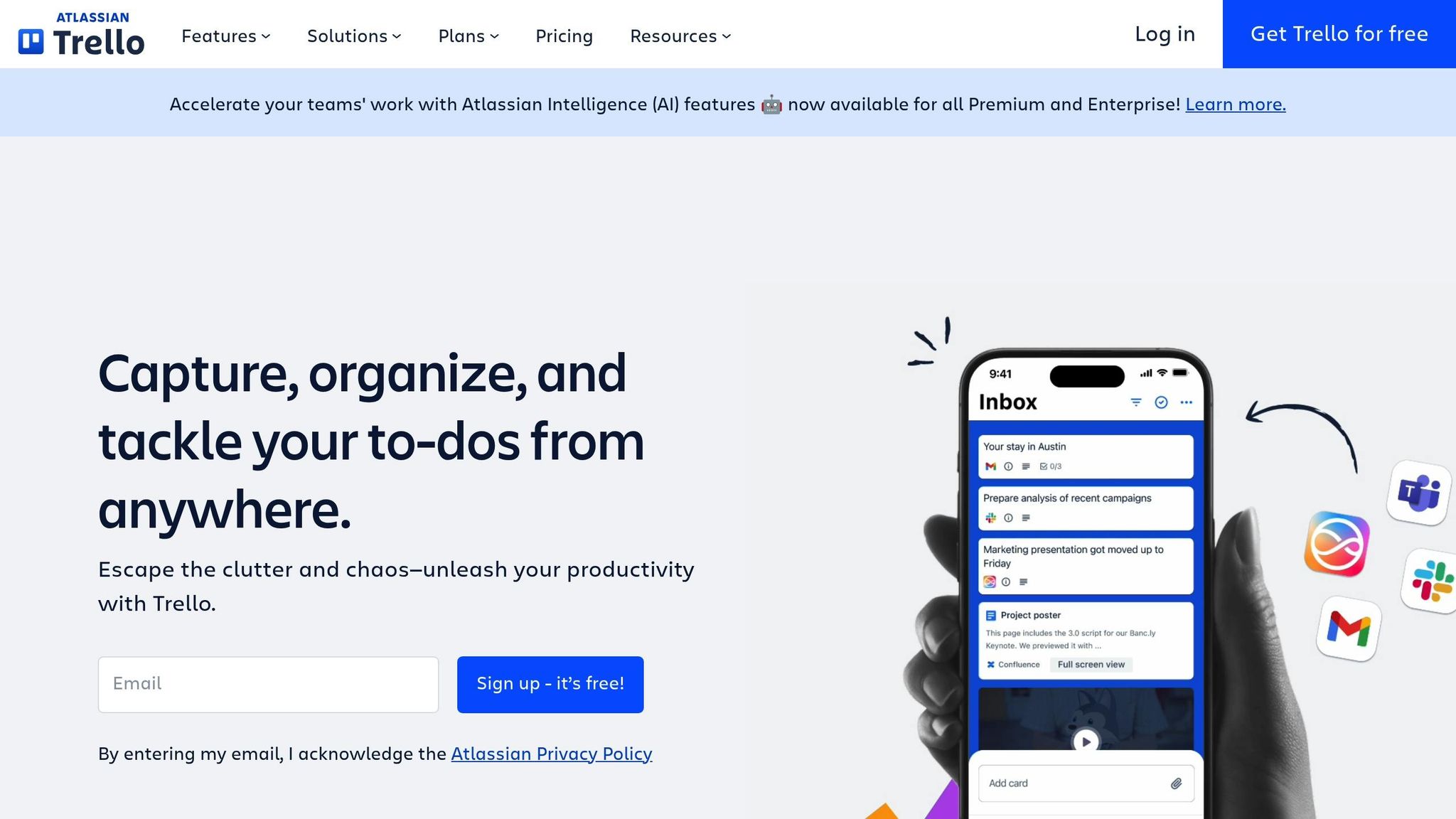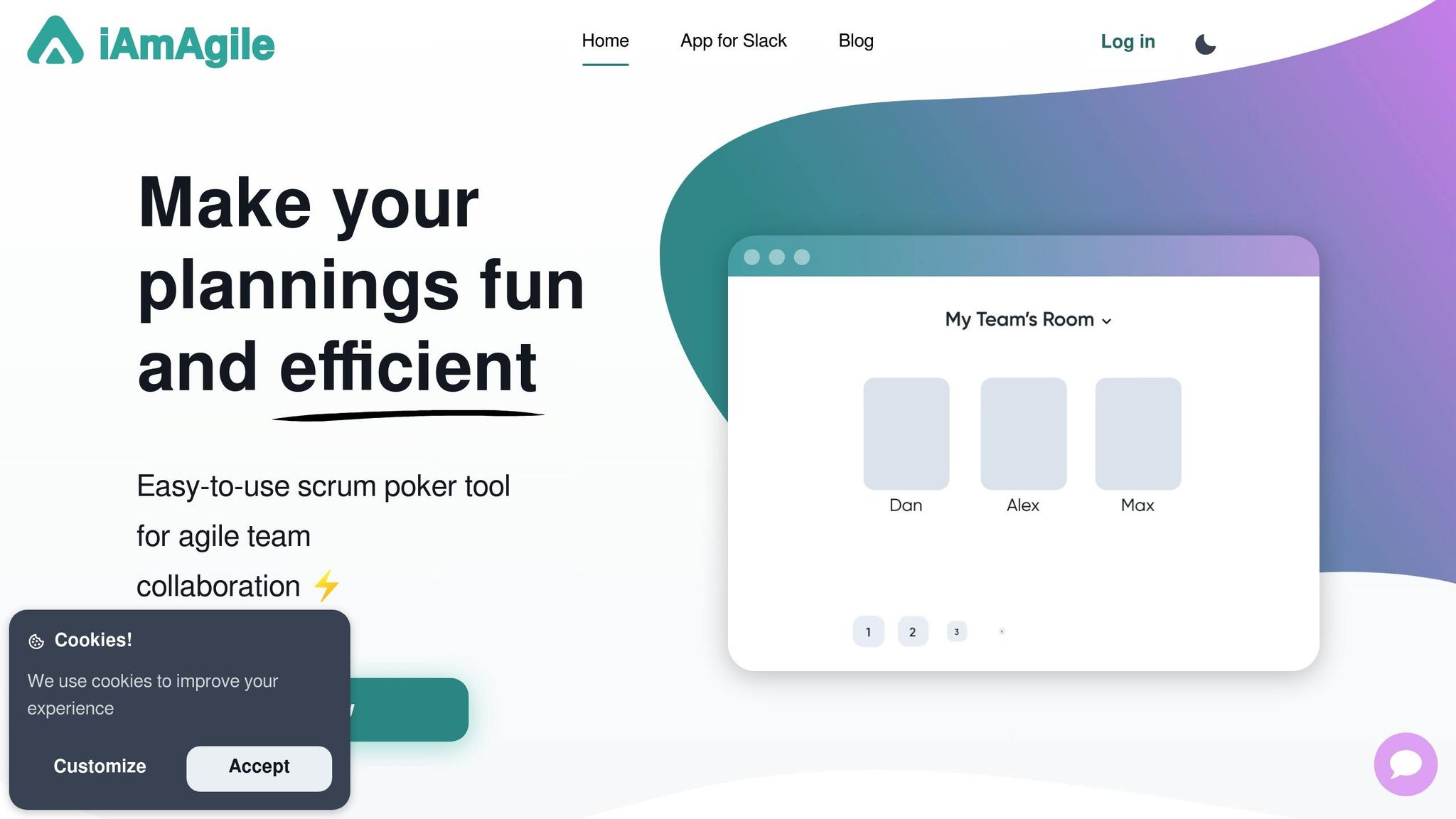Mobile vs Desktop Scrum Tools: Which Works Better?
Published Aug 18, 2025
⦁
10 min read

Mobile vs Desktop Scrum Tools: Which Works Better?
Mobile and desktop Scrum tools each bring distinct strengths to Agile project management. Mobile tools excel in accessibility, offering quick updates, real-time notifications, and touch-friendly interfaces for on-the-go use. Desktop tools, on the other hand, provide powerful dashboards, advanced reporting, and extensive integrations, making them ideal for detailed planning and analysis.
Here’s what you need to know:
- Mobile Tools: Great for quick task updates, remote communication, and smaller teams (5-15 members). Perfect for real-time notifications and simple task management.
- Desktop Tools: Better suited for larger teams and complex workflows. They handle advanced sprint planning, reporting, and integrations seamlessly.
Quick Comparison
| Criteria | Mobile | Desktop |
|---|---|---|
| Accessibility | Instant updates, real-time alerts | Detailed dashboards and planning |
| User Interface | Touch-friendly, simplified | Full-featured, customizable layouts |
| Sprint Planning | Basic backlog updates | Advanced tools, drag-and-drop |
| Reporting | Simple charts | Detailed analytics |
| Integrations | Limited | Extensive, third-party connections |
| Performance | Suited for smaller datasets | Handles large datasets efficiently |
| Collaboration | Quick communication | In-depth discussions and planning |
| Best For | Remote teams, quick updates | Large teams, detailed analysis |
Takeaway: Combining both platforms can maximize efficiency. Use mobile for quick updates and communication, and desktop for detailed planning and reporting.
Mobile vs Desktop Scrum Tools Comparison
Usability and Accessibility
When it comes to usability, mobile Scrum tools shine in providing quick updates on the go. Their touch-friendly interfaces make it easy to adjust task statuses, monitor sprint progress, and reply to notifications, whether you're commuting or working remotely. These apps focus on core functions like viewing backlogs, updating story points, and communicating with team members, all streamlined to work effectively on smaller screens.
On the other hand, desktop platforms offer more comprehensive dashboards, perfect for displaying multiple data points simultaneously. Scrum Masters and Product Owners often favor desktop tools during sprint planning sessions, as they allow for detailed burndown charts, advanced filtering, and drag-and-drop backlog prioritization. The larger screen space makes navigating complex user stories much more intuitive.
The learning curve also differs between the two. Mobile apps are straightforward and require little to no training, while desktop platforms might need a bit more setup time but offer extensive customization options in return.
Now, let’s dive into how these platforms handle features and integrations.
Features and Integrations
Notification systems are an area where mobile tools excel, delivering real-time push notifications to keep team members updated on sprint changes, task assignments, and deadlines. This immediacy makes them perfect for staying in the loop.
Meanwhile, desktop tools take integration to the next level. They connect seamlessly with productivity tools like email systems, calendars, and file-sharing platforms, creating a cohesive project management environment. Their advanced reporting features generate detailed analytics, helping teams track velocity, pinpoint bottlenecks, and make informed decisions for upcoming sprints.
Customization is another key difference. Desktop platforms typically allow for extensive adjustments, such as creating custom fields, automating workflows, and personalizing dashboards. Mobile apps, however, focus on essential functionality, limiting customization to maintain performance and conserve battery life.
Let’s move on to performance and scalability to round out the comparison.
Performance and Scalability
Performance depends heavily on connectivity and device capabilities. Mobile apps are great for quick status checks and adding comments, but they may falter when handling large backlogs or generating detailed reports.
Desktop platforms, with their superior processing power, manage large datasets, bulk operations, and advanced searches effortlessly. They’re better suited for navigating extensive project histories and running detailed analytics without lag.
Team size also plays a role in performance. Mobile tools are ideal for smaller teams (5-15 members) that prioritize quick updates and basic collaboration. For larger organizations with complex structures and multiple stakeholders, desktop platforms provide the robust features and processing power needed to manage intricate workflows effectively.
Comparison Table
| Criteria | Mobile | Desktop |
|---|---|---|
| Accessibility | Instant access, real-time notifications | Detailed dashboards |
| User Interface | Touch-friendly, simplified navigation | Full-featured, customizable layouts |
| Sprint Planning | Basic backlog viewing, quick updates | Advanced planning tools, drag-and-drop |
| Reporting | Simple progress tracking, basic charts | Detailed analytics, custom reports |
| Integrations | Limited to essential apps | Extensive third-party connections |
| Performance | Quick for simple tasks, battery-dependent | Handles complex operations, large datasets |
| Team Collaboration | Quick communication, status updates | In-depth discussions, detailed documentation |
| Learning Curve | Minimal training required | More setup time, greater complexity |
| Best For | Remote updates, small teams, quick tasks | Planning sessions, large teams, analysis |
7 Top Scrum Project Management Tools Reviewed
Platform Analysis: Mobile and Desktop Tool Capabilities
Let’s dive deeper into how top Scrum platforms utilize mobile and desktop functionalities to meet the needs of modern agile teams.
Jira: Enterprise Features Across Devices

Jira's desktop platform is packed with tools designed for enterprise-level project management. It’s built to handle complex workflows, offering advanced filtering through JQL (Jira Query Language) to sift through thousands of issues. The desktop version also excels in reporting, generating burndown charts, velocity reports, and custom dashboards that provide real-time project insights.
On the other hand, Jira's mobile app is more streamlined, focusing on basic tasks like status updates, comments, and notifications. While useful for quick updates during standups or logging time on the go, it falls short when it comes to creating new issues or accessing detailed reports. For teams that juggle both mobile and desktop use, Jira works best when the desktop platform is used for heavy-duty tasks like sprint planning and analysis, while the mobile app handles day-to-day updates. The instant synchronization between devices ensures that any changes made on mobile reflect immediately on the desktop, creating a smooth workflow across platforms.
Trello: Visual Task Management

Trello’s card-based design makes it a natural fit for mobile devices. The mobile app retains the visual simplicity of Kanban boards, allowing users to move cards between "To Do", "In Progress", and "Done" columns with intuitive swipe gestures. This makes it ideal for quick updates during daily standups.
The desktop version, however, is where Trello’s full potential comes to life. It supports Power-Ups like time tracking, calendar views, and custom fields - features that are either limited or unavailable on mobile. The larger screen space on desktop is especially helpful during sprint planning, enabling teams to view the entire backlog and add detailed descriptions, checklists, and attachments more effectively.
Trello’s seamless synchronization across devices ensures that every update is tracked in the activity feed, showing who made changes and when. This makes it a strong choice for distributed teams that need constant visibility into project progress.
iAmAgile: Optimized for Agile Teams

iAmAgile focuses on task estimation through Scrum poker and delivers a mobile-first experience. Whether team members are participating from their phones during remote sessions or using desktop computers in a conference room, the platform ensures smooth operation for planning poker activities.
Its Slack integration is a standout feature, enabling teams to start estimation sessions directly from their communication channels. This integration minimizes the hassle of switching between tools, keeping the focus on collaboration and decision-making.
iAmAgile also offers customizable voting scales, allowing teams to use methods like Fibonacci sequences, T-shirt sizes, or custom point systems based on their preferences. The mobile interface ensures that everyone can participate equally, regardless of their device.
The platform’s interactive engagement tools enhance the productivity of estimation sessions. Teams can see voting progress in real-time, discuss discrepancies through integrated chat, and reach consensus faster than with traditional methods. This makes iAmAgile a great companion for teams that prioritize collaborative estimation while relying on other platforms for broader project management tasks.
How to Choose the Right Tool for Your Team
Selecting the best Scrum tool for your team comes down to aligning its features with your team’s workflow and collaboration style. The right tool should not only support your processes but also enhance efficiency and communication.
Decision Criteria
Different teams have different needs. For smaller, remote teams, mobile-first tools with real-time notifications and simple interfaces are often the best fit. On the other hand, larger, onsite teams might lean toward desktop platforms that offer advanced reporting and extensive customization options.
Think about how crucial immediate notifications are for your team. If staying on top of blockers or deployment issues in real time is a priority, focus on tools with reliable push notification systems.
Also, consider the technical complexity of your projects. If your workflow is straightforward, visual, card-based mobile tools can handle the job. However, for projects that require multiple integrations, custom fields, or detailed tracking, desktop platforms with more advanced configuration options are better suited.
Finally, take budget into account. Mobile-first tools often come with simpler, more affordable pricing, making them ideal for leaner organizations. Meanwhile, desktop solutions, though more expensive, offer a broader range of features and functionality.
Use Cases for Mobile and Desktop Platforms
How your team works on a daily basis can also guide your decision. Mobile platforms are great for quick check-ins and task updates, especially for remote team members or field workers who need to stay connected in real time.
For more complex tasks like backlog management, detailed project planning, and resource allocation, desktop platforms shine. They make it easier to view project timelines, manage dependencies, and groom backlogs effectively.
Many teams find that combining both mobile and desktop tools offers the best results. For example, you could use iAmAgile’s mobile-friendly Scrum poker for collaborative estimation sessions while relying on desktop platforms for overall project tracking. This approach blends interactive features like customizable voting scales with the depth needed for comprehensive management.
Sprint retrospectives are another example: initial feedback collection can be done conveniently via mobile surveys, but creating detailed action items and reports is more practical on a desktop.
Ultimately, the best tool is the one that fits seamlessly into your team’s workflow. If your team thrives on quick communication and straightforward task management, mobile-first solutions are a smart choice. For teams that require detailed analysis and extensive customization, desktop platforms are the way to go.
Final Recommendations for Agile Teams
To manage Scrum effectively, it’s essential to use both mobile and desktop tools in ways that complement each other. The key is to align your team’s core activities with the right platform, as outlined in the earlier comparison.
For quick updates and on-the-go tasks, mobile tools are ideal. On the other hand, desktop platforms shine when handling complex planning sessions or managing your backlog, where more detailed analysis is required. Striking this balance ensures your team stays efficient without compromising on quality.
Take iAmAgile, for example. Their mobile-friendly Scrum poker tool integrates effortlessly with Slack, enabling teams to run estimation sessions from virtually anywhere. With customizable voting scales, sprint planning becomes more dynamic and inclusive. This eliminates the need for everyone to be tied to their desks during planning, making the process smoother and more flexible.
Consider adopting a hybrid workflow that plays to the strengths of both platforms. Use mobile apps for quick status updates and communication, while relying on desktop tools for deeper, more detailed planning. This approach maintains a steady rhythm while still allowing for thoughtful analysis.
Budget is another important factor. Many teams start with simpler, mobile-first tools to handle basic Scrum activities. As their processes grow more complex, they gradually incorporate desktop solutions with advanced features. This step-by-step approach can help manage costs while still meeting evolving needs.
Consistency is crucial when combining platforms. Standardize your tools and workflows to ensure a seamless experience across mobile and desktop. Hybrid strategies work best when they’re implemented with intention and clarity.
Finally, build your tool strategy around your team’s existing habits. Forcing new behaviors can lead to unnecessary resistance, so it’s better to adapt tools to fit how your team already works. This way, the transition feels natural and enhances productivity rather than disrupting it.
FAQs
How can teams effectively use both mobile and desktop Scrum tools to boost productivity?
When teams use both mobile and desktop Scrum tools, it's all about leveraging the strengths of each. Mobile tools shine when it comes to quick updates, managing tasks on the go, and staying connected in real time. On the other hand, desktop tools are ideal for digging into detailed planning, generating comprehensive reports, and managing more intricate workflows.
To keep everything running smoothly, syncing data across platforms is key. Cloud-based solutions are a great way to ensure everyone has access to the most up-to-date information, no matter the device. Setting clear rules for when to use mobile versus desktop tools and offering regular training sessions can also boost efficiency, keeping the team organized and productive.
What should you consider when choosing between mobile and desktop Scrum tools for your project?
When choosing between mobile and desktop Scrum tools, it's essential to align your decision with your team's workflow and priorities.
Mobile tools shine when you need real-time updates and on-the-go access, making them perfect for remote teams or those frequently working outside the office. They’re built for flexibility and quick interactions, keeping everyone connected no matter where they are.
On the flip side, desktop tools often offer more advanced features for tasks like detailed planning, in-depth reporting, and comprehensive analysis. These tools are typically better suited for managing complex projects that demand a higher level of organization and oversight.
To make the best choice, think about how your team collaborates. Do they need instant updates, or are they more focused on detailed management? Also, consider how accessible the platform needs to be for everyone involved. Striking the right balance between these factors will ensure you pick the tool that supports your project's goals effectively.
How do mobile and desktop Scrum tools meet the needs of growing teams differently?
Mobile Scrum tools are great for quick updates and accessing information on the go. However, their smaller screens and streamlined features can make it challenging to manage larger, more complex teams. These tools tend to work best for individuals or smaller teams who need basic functionality without the bells and whistles.
On the flip side, desktop Scrum tools are built to handle bigger challenges. They often come with more advanced features, seamless integration with other software, and enhanced collaboration capabilities. This makes them a solid choice for growing teams that need to manage multiple groups and oversee large Agile projects with ease.
Ready to improve your team's planning?
Put what you've learned into practice! Make your next planning session more engaging and accurate.
Try for free - no signup required